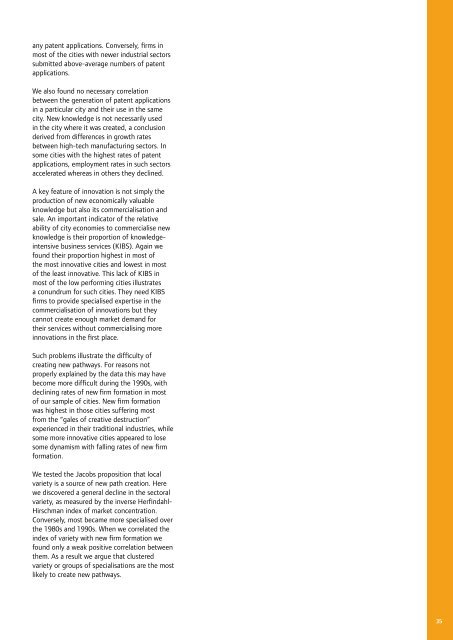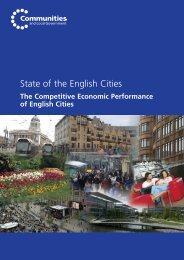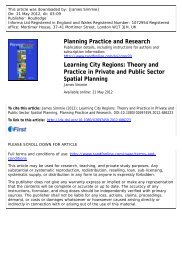History Matters: Path dependence and innovation in British city ...
History Matters: Path dependence and innovation in British city ...
History Matters: Path dependence and innovation in British city ...
You also want an ePaper? Increase the reach of your titles
YUMPU automatically turns print PDFs into web optimized ePapers that Google loves.
any patent applications. Conversely, firms <strong>in</strong><br />
most of the cities with newer <strong>in</strong>dustrial sectors<br />
submitted above-average numbers of patent<br />
applications.<br />
We also found no necessary correlation<br />
between the generation of patent applications<br />
<strong>in</strong> a particular <strong>city</strong> <strong>and</strong> their use <strong>in</strong> the same<br />
<strong>city</strong>. New knowledge is not necessarily used<br />
<strong>in</strong> the <strong>city</strong> where it was created, a conclusion<br />
derived from differences <strong>in</strong> growth rates<br />
between high-tech manufactur<strong>in</strong>g sectors. In<br />
some cities with the highest rates of patent<br />
applications, employment rates <strong>in</strong> such sectors<br />
accelerated whereas <strong>in</strong> others they decl<strong>in</strong>ed.<br />
A key feature of <strong><strong>in</strong>novation</strong> is not simply the<br />
production of new economically valuable<br />
knowledge but also its commercialisation <strong>and</strong><br />
sale. An important <strong>in</strong>dicator of the relative<br />
ability of <strong>city</strong> economies to commercialise new<br />
knowledge is their proportion of knowledge<strong>in</strong>tensive<br />
bus<strong>in</strong>ess services (KIBS). Aga<strong>in</strong> we<br />
found their proportion highest <strong>in</strong> most of<br />
the most <strong>in</strong>novative cities <strong>and</strong> lowest <strong>in</strong> most<br />
of the least <strong>in</strong>novative. This lack of KIBS <strong>in</strong><br />
most of the low perform<strong>in</strong>g cities illustrates<br />
a conundrum for such cities. They need KIBS<br />
firms to provide specialised expertise <strong>in</strong> the<br />
commercialisation of <strong><strong>in</strong>novation</strong>s but they<br />
cannot create enough market dem<strong>and</strong> for<br />
their services without commercialis<strong>in</strong>g more<br />
<strong><strong>in</strong>novation</strong>s <strong>in</strong> the first place.<br />
Such problems illustrate the difficulty of<br />
creat<strong>in</strong>g new pathways. For reasons not<br />
properly expla<strong>in</strong>ed by the data this may have<br />
become more difficult dur<strong>in</strong>g the 1990s, with<br />
decl<strong>in</strong><strong>in</strong>g rates of new firm formation <strong>in</strong> most<br />
of our sample of cities. New firm formation<br />
was highest <strong>in</strong> those cities suffer<strong>in</strong>g most<br />
from the “gales of creative destruction”<br />
experienced <strong>in</strong> their traditional <strong>in</strong>dustries, while<br />
some more <strong>in</strong>novative cities appeared to lose<br />
some dynamism with fall<strong>in</strong>g rates of new firm<br />
formation.<br />
We tested the Jacobs proposition that local<br />
variety is a source of new path creation. Here<br />
we discovered a general decl<strong>in</strong>e <strong>in</strong> the sectoral<br />
variety, as measured by the <strong>in</strong>verse Herf<strong>in</strong>dahl-<br />
Hirschman <strong>in</strong>dex of market concentration.<br />
Conversely, most became more specialised over<br />
the 1980s <strong>and</strong> 1990s. When we correlated the<br />
<strong>in</strong>dex of variety with new firm formation we<br />
found only a weak positive correlation between<br />
them. As a result we argue that clustered<br />
variety or groups of specialisations are the most<br />
likely to create new pathways.<br />
35













